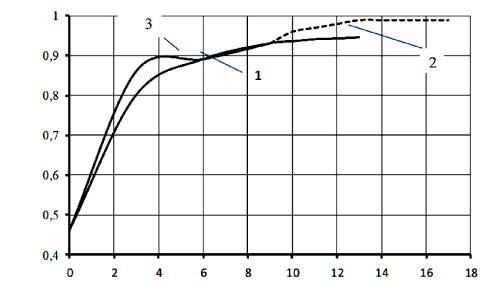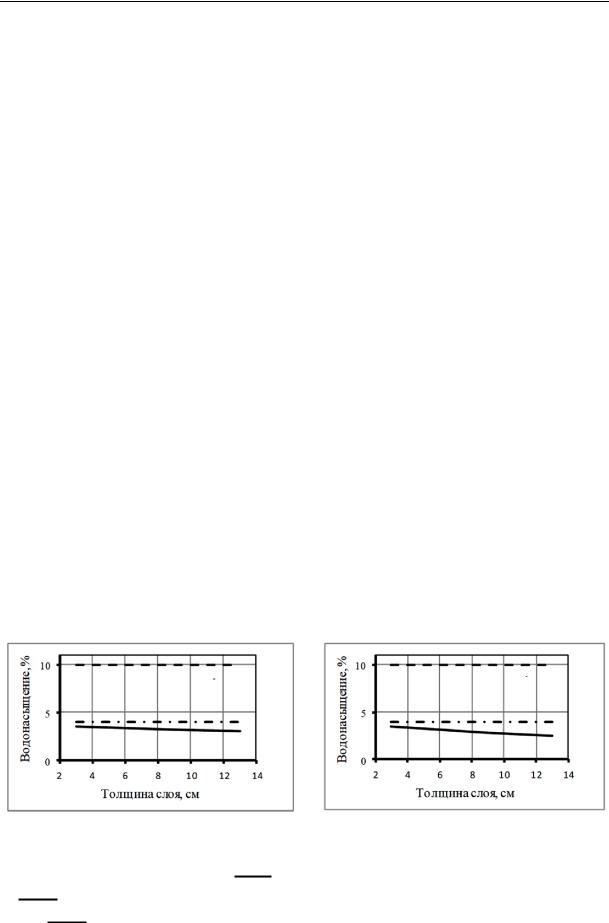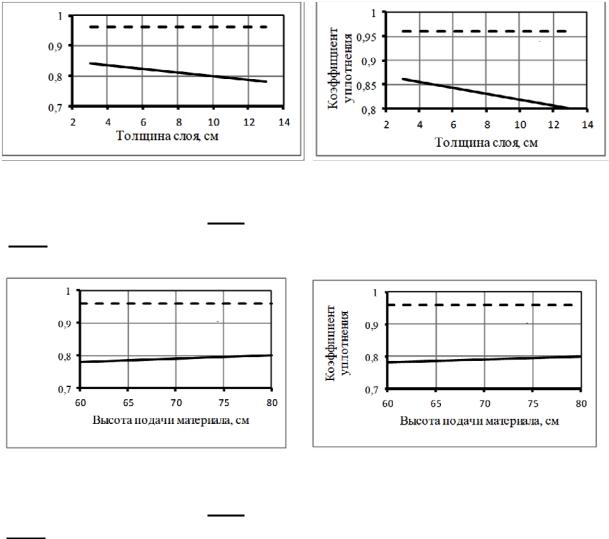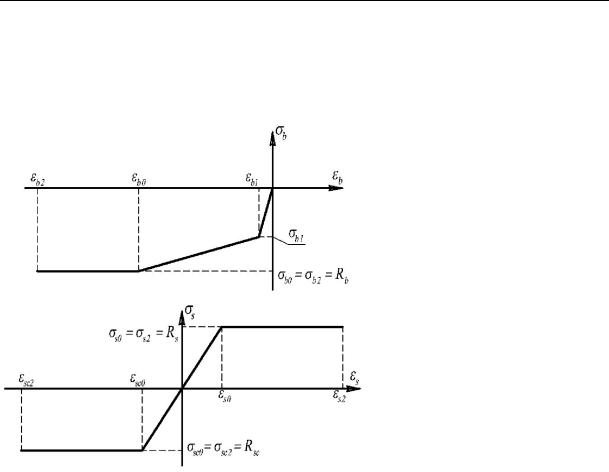
3725
.pdf
Issue № 2 (38), 2018 |
ISSN 2542-0526 |
after the laying by taking chips from the site. The samples were tested in accordance with GOST (ГОСТ) 12801-98. The obtained values were compared with the normative characteristics according to the GOST (ГОСТ) 9128-2009. In order to specify the effect of a compaction method on the compaction coefficient of asphalt concrete, the laid mix was compacted using a vibration plate DPU 3050H, pneumatic tyre (vehicle GAZ-3302 “Gazel”) and a ramming machine [18]. The compaction coefficient was measured with the non-destructive method using the tool PAB-1. The results for compacting a material layer of 0.05 m are presented in Fig. 4.
Compaction coefficient
Number of runs
Fig. 4. Dependence of the compaction coefficient on the number of runs of the ramming machine at the thickness of the layer of 0,05 m:
1 is a vibration plate; 2 is a percussive-action machine; 3 is a vehicle
The data suggest that the use of the liquid-injection method of laying and compacting a mix does not provide a required strength of a material in a pothole. Due to an axial load of vehicles, a required coefficient of compaction of a material in a pothole depends on contact stresses in the pneumatic tyre and a material and traffic intensity. A low compaction coefficient of a mix under the effect of a vehicle (“Gazel”) indicates an insufficient stress strain of a material in the area of contact of a wheel and a material surface in a pothole. As a heavy-weight vehicle moves, the compaction coefficient and thus the strength reach higher compaction. The use of compaction machines allows for higher characteristics of a compacted material depending on the parameters of compaction machines.
51

Russian Journal of Building Construction and Architecture
Tests of the samples for standard compaction showed that as the size of crushed stone of a mix increases, the strength of a mix drops. During laying using the liquid-injection method and a mix with crushed stone fractioned 5—20 mm the strength limit is 0.51—0.76 МPа, for 5—15 mm the strength limit corresponds to 1.01—1.53 МPа and for 3—10 mm the strength limit is within 2.04—2.24 МPа.
2. Results and evaluation of the credivility of a complete multifactor experiment. The results were processed using a complete factor experiment. The factors that influence compaction for the constant parameters of a machine were the thickness of a layer of a bitumen mineral mix (a minimum and maximum value x1 3, x1 13) and the height of feeding the material from the nozzle of the machine to the surface (a minimum and maximum value x2 60, x2 80).
According to the plan of experimental studies, a number of experiments (n = 4) their repetitions (m = 3) was specified considering the influencing factors. The investigated parameters were the density ρ, g/сm3, water saturation r, %, and the compaction coefficient k. During the experiment it was necessary to design the regression equations for the investigated parameters (considering the combination of factors), to test the resulting models and interpret them. According to the obtained values, the dependence of the effect of variable factors on final compaction was determined [1, 6, 8, 9, 13, 15].
Fig. 5 shows the behavior of the function of water saturation r, %, on the factor x1 (the thickness of a pothole layer, сm) for the fixed factor x2 (the height of feeding a material, сm). Fig. 6 shows its dependence on the factor x2 (the height of feeding a material, сm), for a fixed factor x1 (the thickness of a pothole layer).
Water saturation, % |
|
|
Water saturation, % |
|
||
|
|
|
|
|
|
|
Thickness of a layer, cm |
|
|
|
Thickness of a layer, cm |
||
|
|
|
|
|
||
|
|
|
|
|
|
|
Fig. 5. Water saturation functions: is water saturation;
is a normative value of a water saturation index of 4 % according to the GOST (ГОСТ) 9128-2009; is a normative value of a water saturation index of 10 % according to the GOST (ГОСТ)
52

Issue № 2 (38), 2018 |
ISSN 2542-0526 |
The graphs in Fig. 5 suggest that the obtained indices of water saturation of a material correspond with the required standard value according to the GOST (ГОСТ) 9128-2009 that for this type of porous mixes should range from 4 to 10 % of the volume. For a 20 % emulsion in the volume the water saturation is lower than the normative one (a mix is extremely mobile). Change in the thickness of a pothole layer and the height of feeding the material has no significant effect on water saturation of a bitumen mineral mix.
Fig. 6 shows the behavior of the function of compaction coefficient on the factor x1 (the thickness of a pothole layer, cm) for a fixed factor x2 (the height of feeding a material, cm) and Fig. 7 shows its dependence on a factor x2 (the height of feeding a material, сm) for a fixed factor x1 (the thickness of a pothole layer, сm).
The graphs in Fig. 6, suggest that the obtained compaction coefficient of a material does not correspond with the required normative value according to the Road Safety Code (СП) 78.13330.2012 that for asphalt concrete from cold mixes should not be lower than –0.96.
Compaction coefficient
Compaction coefficient
|
|
Compaction coefficient |
|
|
|
|
|
|
|
|
|
|
|
|
Thickness of a layer, cm |
|
|
|
|
|
|
|
Thickness of a layer, cm |
|
|
|
|
|
|
|
|
|
|
|
а) х2 = 60 см |
|
|
b) х2 = 80 см |
|
Fig. 6. Function of a compaction coefficient: is a compaction coefficient;
is a normative value К of compaction according to the Road Safety Code (СП) 78.13330.2012 — 0.96
|
|
Compaction coefficient |
|
|
|
|
|
|
|
|
|
|
|
|
Height of material supply, cm |
|
|
||
|
|
|
Height of material supply, cm |
|
|
|
|
|
|
а) х1 = 3 см |
|
|
|
|
|
|
|
b) х1 = 13 см |
Fig. 7. Function of a compaction coefficient: is a compaction coefficient;
is a normative value К of compaction according to the Road Safety Code (СП) 78.13330.2012 — 0.96
53

Russian Journal of Building Construction and Architecture
As a result of processing the experimental data, the regression equations for the investigated parameters were obtained [1, 6, 8, 9, 13, 15]:
1.91 0.014x1 0.0007x2 , |
(1) |
r 3.25 0.064x1 0.0047x2 , |
(2) |
k 0.798 0.006x1 0.001x2 . |
(3) |
Tests of the obtained equations using the Fisher’s criteria showed that the calculation criteria are smaller than those in the table, which allows us to conclude that the obtained equations are credible. It was found that the final result for laying a bitumen mineral mix with the use of the injection-liquid method depends on the rate of feeding a material from a nozzle of a machine. The height of feeding a material has no significant effect on the compaction coefficient. The obtained values of the parameters are different from the average ones in the accepted range (Table).
|
|
|
|
|
|
Таble |
|
|
Results of testing the equations |
|
|
||
|
|
|
|
|
|
|
The calculated values of the parameters |
Average values of the parameters |
|||||
|
|
|
|
|
|
|
j |
rj |
kj |
j |
|
rj |
kj |
density, |
water saturation, |
compaction |
3 |
|
water |
compaction |
g/сm3 |
% |
coefficient |
density, g/сm |
|
||
|
|
saturation, % |
coefficient |
|||
|
|
|
|
|
||
|
|
|
|
|
|
|
1.91 |
3.10 |
0.84 |
1.91 |
|
3.33 |
0.837 |
|
|
|
|
|
|
|
1.77 |
2.46 |
0.78 |
1.78 |
|
2.71 |
0.783 |
|
|
|
|
|
|
|
1.92 |
3.11 |
0.86 |
1.93 |
|
3.44 |
0.863 |
|
|
|
|
|
|
|
1.78 |
2.47 |
0.80 |
1.78 |
|
2.79 |
0.797 |
|
|
|
|
|
|
|
Conclusions
1.The obtained experimental data deny the existing opinion of manufacturers and users of equipment for the liquid-injection method that it has the advantage of no compaction needed for laying a material in a pothole [14—20, 22, 24, 25].
2.In order to improve the life cycle of a repaired surface of roadways it is proved that extra compaction of a mix in a pothole with compaction machines is necessary.
3.The physical and mechanical properties of a bitumen mineral mix (water saturation, compaction coefficient) are determined for laying using the liquid-injection method considering technological modes of operation during patching non-rigid potholes (of varying depths).
4.The analytical dependencies of the effect of technological modes of feeding a mix on its laying quality in a pothole are identified. For a 20 % content of an emulsion in a mix water saturation is lower than the normative one (a mix is extremely mobile). As an emulsion con-
54
Issue № 2 (38), 2018 |
ISSN 2542-0526 |
tent drops with crushed stone fractioned 5—15 and 5—20 mm, an emulsion content in mixes with crushed stone fractions grows from 6 to 9 %. For mixes with crushed stone fractioned 3—10 mm for an emulsion content of 15 to 20 % water saturation is over the accepted value.
5.An increase in the height of feeding a material does not have a significant effect on the compaction coefficient and as the thickness of a compacted material layer into a pothole rises, there is an insignificant drop in the compaction coefficient.
6.The obtained results of the factor experiment are credible.
References
1.Adler Yu. P., Markova E. V., Granovskii Yu. V. Planirovanie eksperimenta pri poiske optimal'nykh uslovii
[Planning an experiment to find optimal conditions]. Moscow, Nauka Publ., 1971. 282 p.
2.Aleksikov S. V., Belikov G. I., Pshenichkina V. A., Ermilov A. A. Issledovanie temperatury i uplotnyaemosti asfal'tobetona pri remonte gorodskikh dorog [Research of asphalt concrete temperature and compaction during repair of city roads]. Internet-vestnik VolgGASU. Ser.: Politematicheskaya, 2013, vol. 2 (27). Available at: http://vestnik. vgasu.ru/attachments/AleksikovBelikovPshenichkinaErmilov-2013_2(27).pdf
3.Alferov V. I. Dorozhnye materialy na osnove bitumnykh emul'sii [Road materials based on bitumen emulsions]. Voronezh, Izd-vo Voronezh. gos. un-ta, 2003. 152 p.
4.Apestin V. K. O raskhozhdenii proektnykh i normativnykh srokov sluzhby dorozhnykh odezhd [About discrepancy of design and standard terms of service of road clothes]. Nauka i tekhnika v dorozhnoi otrasli, 2011, no. 1, pp. 18—20.
5.Vasil'ev A. P. Spravochnik inzhenera — dorozhnika. Remont i soderzhanie avtomobil'nykh dorog [Directory engineer — road Builder. Repair and maintenance of roads]. Moscow, Transport Publ., 1989. 287 p.
6.Gmurman V. E. Teoriya veroyatnostei i matematicheskaya statistika [Probability theory and mathematical statistics]. Moscow, Vysshaya shkola Publ., 2004. 479 p.
7.Eresko S. P., Zyablov S. F. Tekhnologiya remonta asfal'tobetonnykh pokrytii avtomobil'nykh dorog [Technology of repair of asphalt concrete coverings of highways]. Nauka i tekhnika v dorozhnoi otrasli, 2011, no. 1, pp. 28—30.
8.Ermakov S. M. Matematicheskaya teoriya planirovaniya eksperimenta [The mathematical theory of experiment planning]. Moscow, Nauka Publ., 1983. 392 p.
9.Zhirabok A. N., Lyakhov V. N. Postroenie modelei i granichnye ispytaniya elektronnykh sredstv: metod. ukazaniya [Model building and boundary tests of electronic means]. Vladivostok, Izd-vo DVGTU, 2006. 32 p.
10.Zubkov A. F., Odnol'ko V. G., Evseev E. Yu. Tekhnologiya remonta dorozhnykh pokrytii avtomobil'nykh dorog s primeneniem goryachikh asfal'tobetonnykh smesei [Technology of repair of road coverings of highways with application of hot asphalt concrete mixes]. Moscow, Spektr Publ., 2013. 180 p.
11.Ivantsov V. A. [Physical and mechanical properties of emulsion-treated mineral materials]. Trudy SoyuzdorNII. Vyp. 34. Issledovaniya organicheskikh vyazhushchikh materialov i bitumomineral'nykh smesei dlya dorozhnogo stroitel'stva [Proc. Soyuzdornii. Vol. 34. Studies of organic binders and bituminous mixtures for road construction], 1969, pp. 91—92.
55

Russian Journal of Building Construction and Architecture
12.Kostel'ov M. P. Sovremennye metody i sredstva yamochnogo remonta dorozhnykh pokrytii [Modern methods and means of patching road surfaces]. Ezhenedel'nik «Stroika»: informats.-stroit. portal. Available at: http://www.stroit.ru
13.Krasovskii G. I., Filaretov G. F. Planirovanie eksperimenta [Design of experiment]. Minsk, Izd-vo BGU, 1982. 302 p.
14.Lyubchenko A. S. Sovershenstvovanie sistemy soderzhaniya avtomobil'nykh dorog Rossii s uchetom opyta Germanii [Improving the system of maintenance of roads in Russia, taking into account the experience of Germany]. Vestnik Volgograd. gos. arkh.-stroit. un-ta. Stroitel'stvo i arkhitektura, 2014, no. 36 (55), pp. 149—156.
15.Montgomeri D. K. Planirovanie eksperimenta i analiz dannykh: per. s angl. [Experiment planning and data analysis]. Leningrad, Sudostroenie Publ., 1980. 384 p.
16.Piletskii M. E., Zubkov A. F. [Comparative evaluation of the effectiveness of the methods of pothole repair of pavements of non-rigid type]. Trudy Mezhdunarodnoi nauchno-prakticheskoi konferentsii «Transportnye sistemy Sibiri, razvitie transportnoi sistemy kak katalizator rosta ekonomiki gosudarstva». Ch. 1 [Proc. of the international scientific and practical conference "Transport systems of Siberia, the development of the transport system as a catalyst for the growth of the state economy". Part 1]. Krasnoyarsk, SFU Publ., 2016, pp. 208—211.
17.Piletskii M. E., Zubkov A. F. Analiz sostoyaniya avtomobil'nykh dorog Tambovskoi oblasti i vybor tekhnologii dlya remonta vyboin na pokrytiyakh nezhestkogo tipa [The analysis of a condition of highways of Tambov region and the selection of technologies for repair of potholes on the pavement of non-rigid type].
Nauchnyi vestnik Voronezhskogo GASU. Stroitel'stvo i arkhitektura, 2016, no. 1 (41), pp. 73—82.
18.Piletskii M. E., Nekrasov D. A., Chaplygin I. S. [Results of experimental studies of mixing in jet-injection method]. Trudy 3-i mezhdunarodnoi nauchno-prakticheskoi konferentsii instituta ArkhSiT FGBOU VO «Tambovskii gosudarstvennyi tekhnicheskii universitet» «Ustoichivoe razvitie regiona: arkhitektura, stroitel'stvo, transport: materialy» [Proc. of the 3rd international scientific-practical conference of the Institute Archit of the "Tambov state technical University" "Regional Sustainable development: architecture, construction, transport: materials»]. Tambov, Izd-vo Pershina R. V., 2016, pp. 171—176.
19.Plotnikova I. A. Bolee effektivno ispol'zovat' bitumnye emul'sii [More efficient use of bitumen emulsions]. Avtomobil'nye dorogi, 1974, no. 6, pp. 10—11.
20.Buza E., Omanovic S., Huseinovic A. Pothole Detection with Image Processing and Spectral Clustering. Proc. of the 2nd International Conference on Information Technology and Computer Networks, World Scientific and Engineering Academy and Society (Turki), October, 2013, pp. 48—53.
21.Equipment Rental. Rent Our Equipment. Sitemap Pavement Resources Inc. Available at: http://pavementresources.com/equipment-rental
22. Griffith А. Improved Winter Pothole Patching. State Planning and Research Project, 1998, no. 538, pp. 11—13.
23.Hot Mix Asphalt Repair. Sitemap Pavement Resources Inc. Available at: http://pavementresources.com/hot- mix-asphalt-repair
24.Jones K. M. Wet Weather Pothole Repair. Edition Technical Quarterly of the Texas State Department of Highways and Public Transportation, 1988, February, pp. 1—4.
25.Nazzal M. D., Sang-Soo К., Abbas A. R. Evaluation of Winter Pothole Patching Methods Repor. Final Report. USA, 2014, pp. 13—17.
56
Issue № 2 (38), 2018 |
ISSN 2542-0526 |
26.Research Report: Spray Injection Pothole Patching. The Road Ahead. Virginia, Virginia Transportation Technology Transfer Center, 2003, pp. 1—6.
27.Rioja F. K. Filling potholes: macroeconomic effects of maintenance versus new investments in public infrastructure. Journal of Public Economics, 2003, no. 87, pp. 228—230. Available at: http://www2.gsu.edu/ ~ecofkr/papers/pub2003.pdf
28.Villiers R. L. Maintenance engineering standards to fulfil the legal duty of road authorities towards safe roads. Dissertation presented for the Degree of Doctor of Philosophy. Stellenbosch University, 2016. 246 p. Available at: https://scholar.sun.ac.za
29.Wang P., Hu Y., Dai Y. and Tian M. Asphalt Pavement Pothole Detection and Segmentation Based on Wavelet Energy Field. Journal Mathematical Problems in Engineering, 2017, no. 2017 (2017) Available at: https://doi.org/10.1155/2017/1604130
30.Welcome to Valley Slurry Seal, Co. Valley Slurry Seal, Co. Available at: www.slurry.com/index.php/con- struction-division
57

Russian Journal of Building Construction and Architecture
BUILDING MECHANICS
UDC 624.26
D. M. Shapiro1, A. A. Tarasov2
DEFORMATION NON-LINEAR CALCUALTION
OF NON-CENTRAL COMPRESSED FERROCONCRETE STRUCTURES
Voronezh State Technical University
Russia, Voronezh, tel.: +7-910-344-73-34, e-mail: davshap@mail.ru 1D. Sc. in Engineering, Prof. of the Dept. of Construction Mechanics Ltd. «Mostdorproyekt»
Russia, Voronezh 2Leading engineer
Statement of the problem. There are currently no studies into the issue where practical tasks are applied to practice and the influence of a deformation model on the results of calculations of noncentral compressed ferroconcrete structures is shown.
Results. A description is provided of an algorithm and software of a non-linear deformation calculation of flat and skew non-central compressed ferroconcrete structures with the use of a calculation model accepted in the Health and Safety Regulations (СБ) 63.13330.2012. A feature of a developed calculation method is obtaining and then using the variable specified geometric characteristics of a section (area and moment of inertia) depending on an external axial force and bending moment. There are examples of calculations using a deformation model of non-central compressed ferroconcrete piles and posts showing the differences between the results and ways of testing for strength and crack-opening compared to traditional methods.
Conclusions. The algorithms and the software set forth in the article allow technical capacities of a progressive theoretically rigid non-linear deformation model of non-central compressed ferroconcrete elements to be implemented.
Keywords: ferroconcrete structures, non-central compression, deformation model.
Introduction. In modern designing and scientific studies, the use of a deformation model of calculating bent and eccentrically compressed ferroconcrete structures introduced by the guidelines of the Road Safety Code (СП) 52-101-2003, (СП) 52-102-2004 and (СП) 63.13330.2012 (section 8.1). Expended introduction of this currently new model evidently involves the development of numerical calculation methods and finds its way into modern concepts of designing construction structures.
© Shapiro D. М., Таrasov А. А., 2018
58

Issue № 2 (38), 2018 |
ISSN 2542-0526 |
An example of successful introduction of a deformation model is designing and practical use of a non-linear method of calculating bridge slab beam span structures [13—16]. In the above papers there is a description of a deformation calculation of bent beams of T-shaped and I-beam sections with mixed reinforcement as well as ordinarily and preliminarily strained ones in particular. A feature of the developed calculation method is obtaining and further using the variable specified geometric characteristics of a section: an area Ared and an inertia moment Ired depending on the moment of external forces when there is no compression – stretching.
In the present article there is a description of a deformation method of calculating eccentrically compressed ferroconcrete supports and piles of random sections with regular reinforcement and it is a follow-up of the above papers.
A large group of scholars have explored the problem [1, 2, 4—11, 17—21]. What all the proposed calculation methods have in common is the use of non-linear relations between strains and deformations and the major differences are in the use of different equations of states or variable constants. Stretching strains in concrete are dealt with in [4, 8, 9, 11, 17—19] and are not in [1, 5—7]. Dependencies between the strains and deformations of concrete in the studies [1, 4—9, 11, 17—19] are accepted as polygonal diagrams according to the Road Safety Code (СП) 63.13330.2012 and [21] and curved diagrams according to [2, 10, 20]. In the calculation methods using the methods in [1, 4—9, 11, 17—19] a reverse task is employed where strains are determined using the specified deformations and calculations of ferroconcrete sections are performed by means of iteration methods or sequential approximations.
In the studies [1, 4—7, 9, 11, 17—19] a hypothesis of flat sections is employed. In [8] a calculation method considering actual diagrams of strains of concrete [10] and allowing the curvature of an eccentrically compressed columns to be determined taking into account warping of a longitudinal section of an element.
1. Description of a calculation model. Geometric characteristics of sections. A theoretical foundation of the below calculation method is kinematic conditions accepted in the Road Safety Code (СП) 63.13330.2012 of a hypothesis of flat sections and assumption on the deformation of concrete and reinforcement according to the diagrams in Fig. 1 and the equations (1), (2) describing them:
|
|
b1 |
|
0.6R , |
|
|
|
b0 |
|
R , |
|
b1 |
|
b1 |
Eb |
, |
|
b0 |
0.002, |
|
b2 |
0.0035, |
(1) |
||||
|
|
|
|
|
|||||||||||||||||||||||
|
|
|
b |
|
|
|
|
b |
|
|
|
|
|
|
|
|
|
|
|
||||||||
|
|
|
|
R , |
|
|
|
|
|
R , |
|
|
|
|
s0 |
Es |
, |
|
|
sc0 |
, |
|
|
0.025, |
(2) |
||
|
|
|
|
|
|
|
|
|
|
|
|||||||||||||||||
|
|
|
s0 s |
|
|
sc0 |
|
|
sc |
|
s0 |
|
|
|
|
sc0 |
|
Es |
|
|
s2 |
|
|
||||
59

Russian Journal of Building Construction and Architecture
where Еb, Rb is an initial modulus of elasticity and calculation compression resistance of concrete; Es, Rs=Rsс are moduli of elasticity and calculation stretching and compression resistance of reinforcement; the rest of the denotations are in Fig. 1.
a)
Fig. 1. Diagrams of the dependencies
b)
ε = f (σ):
а) of concrete; b) of reinforcement
The stretching resistance of concrete is not taken into consideration (σbt = 0).
Let us distinguish a complete section that contains concrete within its geometric size, stretched and compressed reinforcement and its operating part with no operating zone where σbt = 0. Tasks involving a one-axial (flat) or two-axial (slanting) eccentric (in relation to two inertia axis) compression are solved as reverse with sorting through solutions with each of them being a combination of longitudinal force and moments in relation to the section axis.
2. Flat eccentric compression. The investigated section is divided into elementary strip sections sized bz×dz where relative deformations ε are fixed and determined depending on leading deformations of a lower (εТ1) and upper (εТ2) faces with the coordinates z = −z1 and z = z2 (Fig. 2). Leading deformations εТ1 and εТ2 are accepted as independent variables and change in the range from εb2 to εs2 with a specified step dε.
Each of a variety of selected solutions of a flat reverse task contains the following parameters of a calculation identified depending on a specified plain of the distribution of relative deformations along the height of a section:
––a longitudinal force N, moment М applied to the center of gravity of a complete section;
––distribution of strains along the height of a section in concrete and reinforcement;
––the specified geometric characteristics of the operating part of a section.
60
